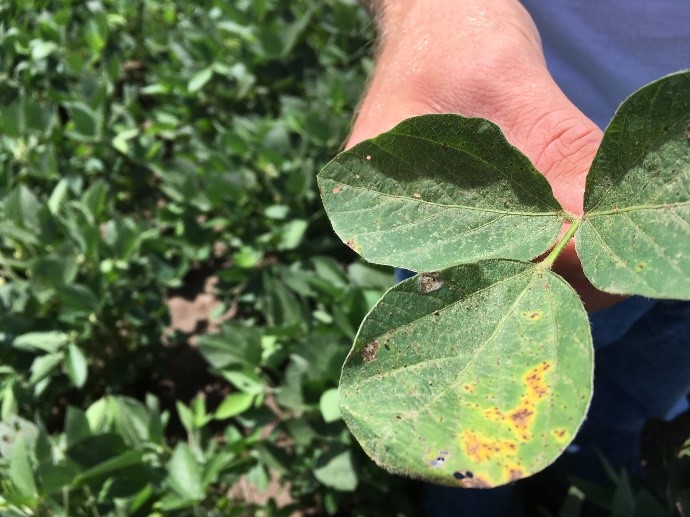With profit margins looking thin for both corn and soybeans, there is a temptation for many producers to avoid applying fungicides and insecticides. Is this a good decision or does it pay to spray?
Corn and soybeans both suffer from fungal diseases. Some years are worse than others so the producer must spend ample time scouting fields to see if pressure exists to the point of needing to apply a fungicide. We know research has shown that yields can be increased by 10-15 bushels by applying fungicides where there is limited disease and 15-30 bushels on corn that has a higher infection. The timing of application is critical. Most corn applications should be completed by early tassel for the best results. After this point of maturity, the effectiveness of applications can decrease substantially.
This year, as we scouted corn fields, we found only limited amounts of fungal diseases in our corn. We were prepared to spray corn at the start of tassel but we were in a severe dry spell at the time. These fields had been 30 days without rain and we were concerned more about pollination than with the low fungal pressure at that time. I made the call not to spray the corn due to the dry weather. A week after this decision we were blessed with some crop saving rains of 2-6 inches depending on the location. The decision had already been made and the optimal window to spay corn had come and gone. However, several of my neighbors did apply prior to the rains. Harvest time will tell who made the right decision.
Soybeans, on the other hand, are another story. Scouting fields this week we found some disease and insect pressure that was of concern.
This plant disease was identified as Septoria Brown Spot. This is a fairly common leaf disease that usually appears first on the lower leaves and moves upward as it progresses. Seldom does this disease cause yield losses but in this case, we saw considerable pressure in certain parts of the field where the disease had moved all the way to the upper parts of the plant.
What we didn’t find was any Frogeye Leaf Spot or Brown Stem Rot. Both of these have been present in the past and have contributed to yield loss. A few years ago, we decided to spray fungicides on a portion of the bean acres and saw a positive response. We now budget for this application each year. On our farm we can usually expect to see a 5 to 7 bushel increase in soybean yield when fungicide is applied. In addition to the yield increase we also expect to see a better quality of bean.
When fungicide is applied, the plant stays healthier longer and spends its energy in producing seed, not fighting diseases. The plants will stay greener longer which may delay harvest a day or two but when you look in the tank, the beans will be of better quality.
Insecticides are usually included when fungicides are applied. With the generic products today, good control can be expected at a very reasonable cost. For the last several years producers have been very concerned about Japanese Leaf Beetles in both corn and soybeans. These insects can damage corn if the pressure is high at silking but yield damage is usually minimal. Soybean producers don’t see a great problem until there is 50% defoliation.
Stink bugs, on the other hand, are a very damaging insect that can contribute to substantial yield losses in soybeans. These sucking insects feed on both the leaves and pods which can cause significant yield loss. The stink bug does the most damage when it feeds on the pod by piercing it and sucking the fluid from the developing bean. This feeding can cause the pod to harden and drop from the plant. Seeds that do survive will be shriveled, smaller, and discolored. This type of damage will lower the quality and the grade of soybeans. Even moderate pressure from this insect will make applying insecticide pay.
Applying fungicides and insecticides will have a positive return when looked at over a number of years but scouting and timing is everything. A fungicide applied too late or an insecticide that is applied after damage has occurred is a waste of money. However, if scouting identifies a problem then applications of these products are very beneficial. It is important to remember, if we can reduce stress on a plant, we can allow it to maximize grain fill by putting energy toward producing yield instead of recovering from injury and disease.




